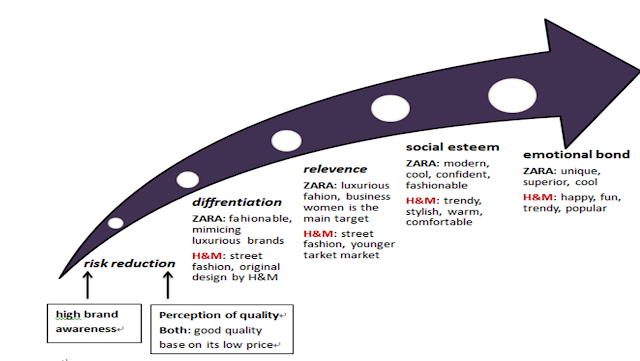Comparing with H&M, or other similar
companies, Zara does not spend much money on promotion. It spends 0.3 per cent
of sales on advertising compared to average of 3.5 per cent of competitors. Zara
thinks that the store windows and the content is the most necessary advertising
for them.
All H&M’s advertisements are produced
centrally at the head office in Stockholm. This means that the advertisements
are largely the same in all markets, but the media mix is adapted to local
needs and circumstances. The centralized, organizational structure ensures a
uniform branding of H&M in all markets. This means that customers will get
the same H&M experience whether they enter a store in Stockholm, Paris or
Hong Kong.
Community websites
To promote H&M and its product, H&M
will use video advertisements, print advertisements and the concept of
e-marketing. These promotion and communication strategy will tend to meet the
consumers form different places everywhere, especially those target markets or
the consumers in the working place. H&M engages
consistently with consumers on Facebook, You Tube and Twitter to drive traffic
to its online stores as well as the physical stores which continue to be
H&M’s most important channel of communication as they give customers an
immediate sense of what H&M is all about. H&M uses its online media
more and more to communication its activities externally.
In different industries have been tried
to use the internet as their part of marking strategy. H&M may invite some
famous bloggers to update the fashion blog every day, and show the latest
fashion news around the world. However, they are not the reporters. The fashion
news is typing by their preference. It may attract more subscribers or fans and
bring more real feedback from the customers.
On the
other hand, Zara also has taken advantage of this low cost advertising. They
have a Facebook, a Twitter, and a Youtube channel account. The posts are about
the photos of their merchandise, look books and activities. They focus on
fashion, current trend and its new products. In 2012, Zara was ranked the 18th
most liked Facebook company by business insider, which is slightly more than
H&M which has 11 million.
Mobile Apps
Nowadays, mobile
phone become the new channel of marketing promotion. Mobile Apps may help to
get close with the customers and company. The customers can easily to touch
their new products when they are launched. Moreover, it can be collected the
updated feedback from customers.
Zara launched an App
for Iphone, Android phone and Tablet. It can be founded the Zara’s latest
fashion items, as well as the contents from Zara website. In addition,
customers can purchase the product through the App. In the other words, people
can purchase their products wherever and whenever.
Current strategies
of H&M also are marketing to its customers through a mobile marketing
campaign. For this mobile marketing strategy, customers may receive SMS
coupons, some mobile banner ads will places on major portals and media sites.
H&M is using Mobiento to market this strategy and its sister company
Adiento, which is an ad network. H&M launched their first campaign in 2006
and is still continuing to use this channel to cover a wide range of consumers.
The main goal for this marketing technique is to promote the latest seasonal
trends for that particular season and to drive membership of the H&M Club.
Moreover, H&M combines
the mobile marketing strategy and social media website, to hold some marketing
campaigns. Customers are encouraged to use their mobile phone to photograph
examples of fashion items they find and like and unload them to the H&M
Facebook site. Then, the customers can review the “hunted” items and vote for
it by using the “like” function in Facebook. The items with the most votes will
get the H&M’s prize. At the same time, H&M has direct access to
everyone who has unloaded photos and voted, they have highly targeted and
engaged audience to promote the suitable products to. It is essentially for
customers to tell H&M what they want and then H&M sell it to them
correctly.







